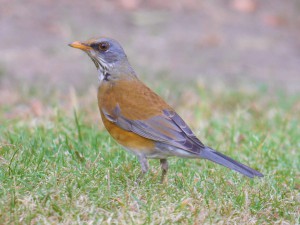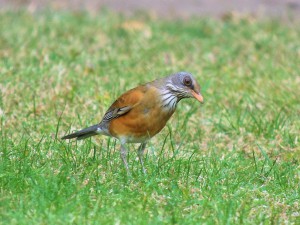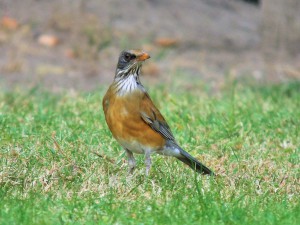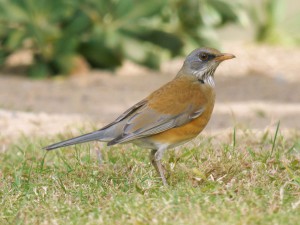Last weekend, we drove out to Twentynine Palms, CA to look for a Rufous-backed Robin previously reported there. The bird had been present for at least a week on the lush grounds of the 29 Palms Inn resort. This resort is a 70-acre oasis of greenery and water for wildlife in the middle of the Mojave Desert, and the owners and operators of the inn are very birder friendly. Thus, it consistently draws in wildlife of all kinds from the surrounding desert. The 29 Palms Inn sits close to Joshua Tree National Park, in extreme south central San Bernardino County, CA.
Description of Rufous-backed Robin
The Rufous-backed Robin (Turdus rufopalliatus) is a slightly smaller relative of the familiar American Robin (Turdus migratorius). Many easily visible differences separate the two species. Hence, distinguishing a Rufous-backed from an American Robin is pretty trivial with any kind of decent look. American Robin has a bright white eye ring that Rufous-backed lacks. Subtly, the orbital ring of Rufous-backed Robin is orange, roughly the same color as the iris. Consequently it’s often hard to see.
Rufous-backed Robin has extensive reddish color on the back and wing coverts where an American Robin is solid gray. Usually, American Robin exhibits a blackish head and a white throat with short, fine, black streaking. In contrast, Rufous-backed Robin sports a pale gray head and a large white patch extending to the breast and along the sides of the throat. Most often, its black streaking is longer and coarser. In addition, this bird had orange traces in the crown and the wings, something no American Robin would ever show.
Status and Distribution
Normally, Rufous-backed Robins live in the dry, deciduous forests on the west coast of Mexico from Sonora to southeastern Oaxaca. Like American Robins, the Rufous-backed readily uses man-made habitats like gardens and farms. As a rule, it fares quite well in those edge habitat areas. Within such habitats, these robins forage on the ground or perch at nearly any height of the canopy. Like the American Robin, Rufous-backs are omnivorous, consuming a diet of fruits and invertebrates.
Typically, Rufous-backed Robins are uncommon but regular vagrants in the states along the Mexican border. Further, in California, we find them in fall and winter, presumably as a function of post-breeding dispersal. Often, they winter in the company of American Robins. The 29 Palms bird associated loosely with a flock of about 20 American Robins. We watched this male Rufous-backed Robin consuming palm fruits. Amusingly, it also hopped around pulling worms out of the lawn, just like any American Robin would.
These photos were digiscoped, using a Kowa TSN-883 spotting scope, a Sayegh Digidapter for Kowa TE-10Z and TE-11WZ mounted on a Kowa TE-11WZ 25-60x Zoom Eyepiece , using a Nikon CoolPix P300 point-and-shoot camera.




